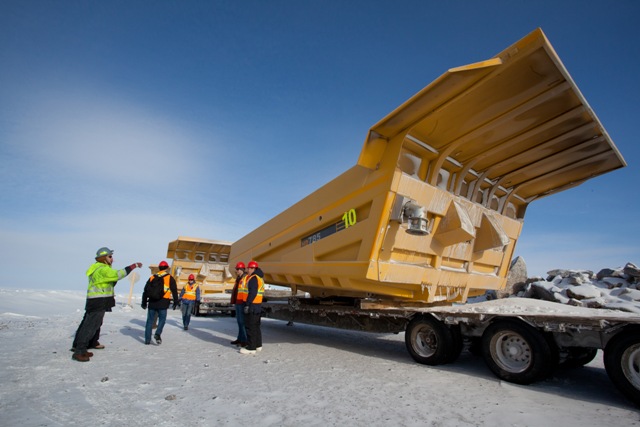If you ask Patrick Evans, chief executive of Mountain Province Diamonds (TSX:MPV; NYSE: MDM), what surprised him most about the results of an updated feasibility study released in April for the company’s joint-venture Gahcho Kué diamond project with De Beers in the Northwest Territories, he’ll point to three key findings.
First: A 13% increase in probable reserves to 35.4 million tonnes grading 1.57 carats per tonne for 55.5 million carats, and, as a result, the extension of the mine life to 12 years from the 11 years outlined in the December 2010 feasibility study.
Second: That during the mine’s ramp-up period between September 2016 through January 2017, about 1 million carats of diamonds will be produced, which will offset working capital requirements during the construction period as well as operating costs during the ramp-up stage. The revised feasibility study estimates ramp-up operating costs through January 2017 will come in at $82 million on a 100% basis. Evans notes that Mountain Province’s share of diamond production during those critical months will be worth about $70 million.
Third: That the sustaining capital over the life of the mine and closure costs are — at $92.7 million — quite a bit lower than the $150 million Mountain Province had initially expected.
Mountain Province owns a 49% stake in the diamond project and De Beers, the project’s operator, a 51% interest.
“There were a few pleasant surprises based on our expectations and all of them were on the plus side, which is always encouraging,” Evans said in April. “Getting the feasibility study update out has certainly been a milestone for us. It’s a huge relief to have it behind us and that the mine remains economically robust.”
The latest study estimates that the open-pit operation will produce 4.5 million carats a year over 12 years for a total of 53.4 million carats, and at revenues of US$149.66 per carat. The project’s post-tax net present value is pegged at $1.01 billion (at a 10% discount rate) and its after-tax internal rate of return (IRR) 32.6%. First production has been delayed from mid-2016 until the third quarter of that year.
Based on the production of 5.6 million carats per year (on a 100% basis) in the first three years of production, or 2.75 million carats a year for Mountain Province, gross revenues for the company are estimated at $412 million per year during that period, or $240 million after all costs, which yields a payback of less than two years, Evans calculates.
Like many mining projects these days, however, costs have escalated somewhat from the initial feasibility study. Capex to completion (on a 100% basis) is $858.5 million, including a $76-million contingency, up from a previously guided $755 million. and operating costs are estimated to come in at $72.51 per tonne, up from a previously guided $65 per tonne.
The cost creep, however, doesn’t worry Evans in the least. He points out that because Mountain Province’s share of production during the mine’s ramp-up stage will contribute about $70 million to its treasury, the company is effectively on the hook for between $330 million and $350 million to bring the mine into production. More importantly, he says, annual cash flow from the production of 5.6 million carats during each of the first three years of production will be about $400 million.
“For us to have to arrange a $350-million financing for something that is going to be generating $400 million a year on average is a relatively straightforward task,” he says. “When you’ve got an IRR of over 30% you really don’t have any difficulty raising money on the equity and debt markets.”
Mountain Province will likely raise about two-thirds of the money (about $250 million ) through project finance and about one third (or about $100 million) via equity. Evans says the company has ruled out offtake agreements.
Of course it helps that the junior has a shareholder with deep pockets and a big appetite, it would appear, for diamonds. Irish billionaire Desmond Dermot has acquired a 24% stake in the company through his private investment vehicle, Bottin Investments, and has been involved in most of the company’s recent equity raises, even agreeing to underwrite a $50-million rights issue himself in 2012. “If we do a further equity issue of about $100 million it will likely be in the form of a rights issue and Mr. Dermot has indicated he will fully underwrite that again,” Evans says.
The equity markets “are wide open to us,” he continues, noting that late last year when it became apparent that the revised feasibility study was going to be delayed, the company arranged a $30-million non-brokered private placement just by picking up the phone and calling existing shareholders.
In March, when the release of the feasibility was delayed yet again, Mountain Province had to raise an additional $28 million. “We were able to do it without any difficulty and at a higher price than we did raising money last December,” Evans says. “It has solely to do with the quality of the asset and the quality of our operating partner.”
Having De Beers as a partner clearly puts Mountain Province in an enviable position among the handful of diamond mine developers, not just because of the company’s storied history and track record in diamond mining, but because of its financial clout.
At the end of the day, Evans emphasizes, it all boils down to grade. “Gahcho Kué is the highest grade diamond mine being developed,” he says. “It has more than twice the grade than the next diamond mine being developed: Stornoway Diamond’s Renard project. Money is looking for quality and the quality is in the grade and the grade is what results in the phenomenal cash flow.”
As far as permitting is concerned, the JV partners received approval to develop the mine from the federal government in October and has signed impact benefit agreements with the North Slave Metis Alliance, the Yellowknives Dene and the Tlicho First Nations. IBAs have yet to be signed with the Lutsel K’e First Nation, Deninue Kué First Nation and the NWT Metis Nation, but Evans is confident that negotiations will be successful.
Gahcho Kué is the fourth diamond mine to be built in the Northwest Territories and the second that De Beers has permitted there, Evans explains.
“De Beers learned a great deal from the Snap Lake IBA,” he says. “The relationship with the First Nations communities already exists, so we’re not starting from ground zero and that helps facilitate the whole process.”
As for the final two permits the project needs before mining can begin — the Class A Water license and a Class A Land Use permit — Evans forecasts they will be approved before the end of the third quarter.
Not having those permits in hand for the ice-road season that just ended meant the partners could not truck in cement and steel for construction. That will mean a project delay, but De Beers believes it will be minor — meaning production in the third quarter of 2016, rather than the second quarter.
At the end of March, about 20% of construction was already completed, and 800 truckloads of equipment and supplies had been sent via ice road to the site.
Evans is also careful to note that there is excellent potential to expand the mine beyond the initial mine life of 12 years, and says he envisions a total of four phases to Gahcho Kué. The first phase, which is the subject of the current updated feasibility study and permitting, is based on a reserve of 55 million carats from three kimberlites — 5034, Hearne and Tuzo.
If the current inferred resource of 18.5 million carats from the same three kimberlites — essentially the depth extension from 300 metres to 350 metres — is open-pittable, that could extend the mine life by four years to 16 years.
And drilling has already started to increase the depth of the Tuzo kimberlite to 750 metres from 560 metres, which adds the possibility of an underground mine scenario.
“Based on what we know now of Tuzo Deep, it could add about 12 million carats and a further three years of mine life, taking us from 16 years to 19 years,” Evans says.
In a potential fourth phase, the partners may be able to add resources from a fourth kimberlite called Tesla, in addition to possible depth extensions at 5034 and Hearne that have not been defined. If that were the case, the partners could add four or five years to the mine life — bringing Gahcho Kué up to more than 20 years of production.
— Trish Saywell is a senior staff writer with The Northern Miner.






Be the first to comment on "Gahcho Kué takes shape"